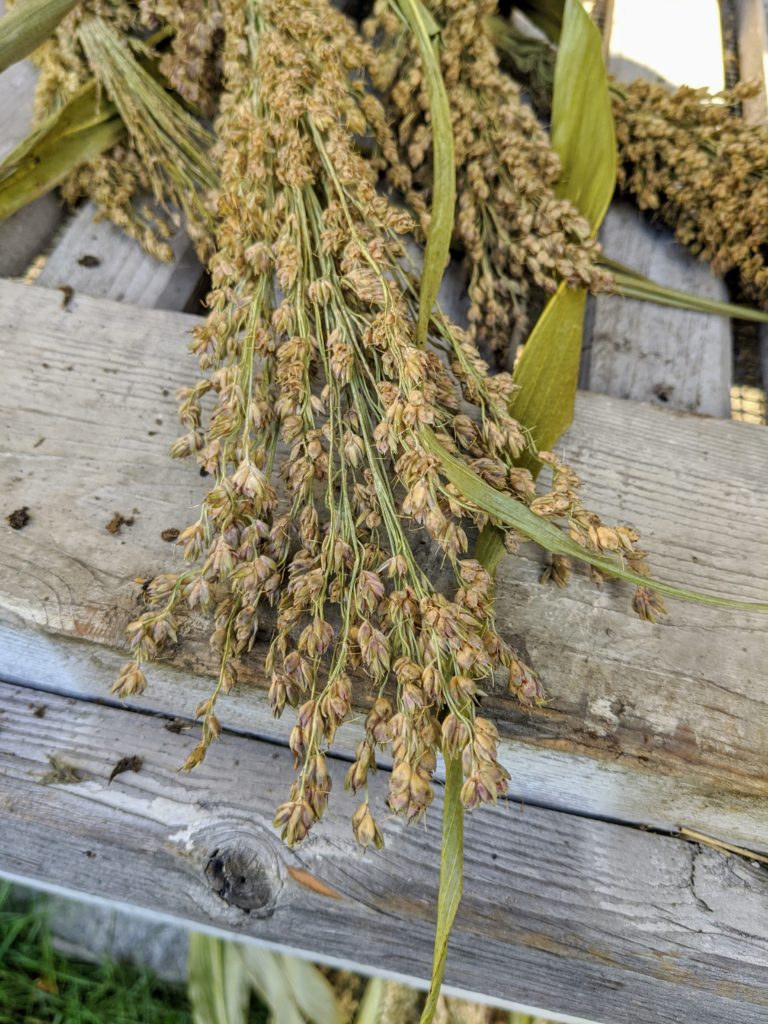
Planting in a no-dig garden consists of pulling back the mulch to drop in a small number of seeds. This will also depend on the variety, which we’ll give examples to below. Others report that broom corn can rise up to 5 m (15 feet). We live in a cooler, mountainous climate, so that was to be expected. Our crop reached a maximum height of 2 meters (just shy of 7 feet). Think carefully about this, since broom corn does have the potential to shade other garden crops.
#Broom corn for broom making full
Planting Broom Corn in Your No-Dig Gardenīroom corn grows best in full sun, so start there.įind a nice place in your garden, even against a fence or wall to sow your seeds. The requirements of broom corn are very similar to that of growing corn, or sorghum. Growing broom corn isn’t a skill to simply sweep under the rug, so let’s go over what you need to know.Īfter all, it is a survival skill, that can grow in your survival garden, and can help keep your house clean for years to come.

Yet, sometimes we grow plants for the nostalgia of it all. It takes a ton of broom corn to produce several hundred brooms. The reason you don’t see large fields of it anymore, is because it isn’t exactly a high-value crop. Large acreages were planted in the 1830s, and for several decades more, as the popularity of broom corn production, along with the making of brooms, moved west. However, if you consider the number of people needing brooms before electricity came along, you can envision a need for an alternative. We’ll get to this later on, but it’s worth knowing that it takes several plants to make your own broom.

It’s known that broom corn was originally planted in home gardens, not plantations. The sweeping sensation of broom corn production… But my question to you is this: have you ever seen fields of it waving in the breeze? Probably not, though you can attempt this by planting it in your backyard. From there it spread west as far as New Mexico and Colorado. Dry harvested plants before using them in crafts.In the 1700s, Benjamin Franklin was credited with introducing it to the United States. This is after the seedpods are developed. Broomcorn plant care involves pest control and harvesting at the right time. Try them in a sunny spot in your garden or around your yard. If you don’t have a field, but wish to grow a few plants, Locate plants six inches (15 cm.) apart in rows that are at least a foot (30.5 cm.) apart. Preparing beds for an entire crop includes “plowing, disking, and double harrowing” of the soil. The best quality of this crop grows on silty, loamy soils that are well-draining, moist, and fertile. Broomcorn is flexible to grow in different soils and tolerates heat and drought. Growing broomcorn is similar to growing a crop of field corn. If you have the inclination for DIY decorativeīroomcorn items, and the room to plant a crop, get started in late spring. When purchasing broomcorn, you’ll find it in natural hues and dyed withīroomcorn growing is simple and can provide materials for It takes approximately 60 heads (sprays) to make a broom.įloral arrangements and wreaths need even less of the Witches’ brooms, often used in Halloween and autumn displays, are made from raw, broom straw. Baskets and autumn arrangements benefit from the long fibers. Broomcorn Usesīroom straw, while no longer as much of a household necessity, has found new, interesting uses. This sorghum differs from others in that the stalks have little value as livestock feed. Now, broomcorn uses are largely for decorative products. It was a type of sorghum used exclusively for making brooms and whiskbrooms until these became less necessary. The crop was measured by how many hundreds of brooms it produced.

Many people grew their own broom straw and made their own brooms. But, just in the previous century, brooms were regularly used as a cleaning device. Many brooms are replaced these days with some type of small, electronic sweeping device or with a sweeper product that grabs dust, dirt, and hair. In addition to more traditional brooms, the broomcorn plant wasĪlso used for whiskbrooms, a short, hand broom that may still be used Do you wonder where those broom straws originate, the ones that are bound tightly into the broom you may still use for sweeping porches and hardwood floors inside? These fibers come from a plant called broomcorn ( Sorghum vulgare var.


 0 kommentar(er)
0 kommentar(er)
